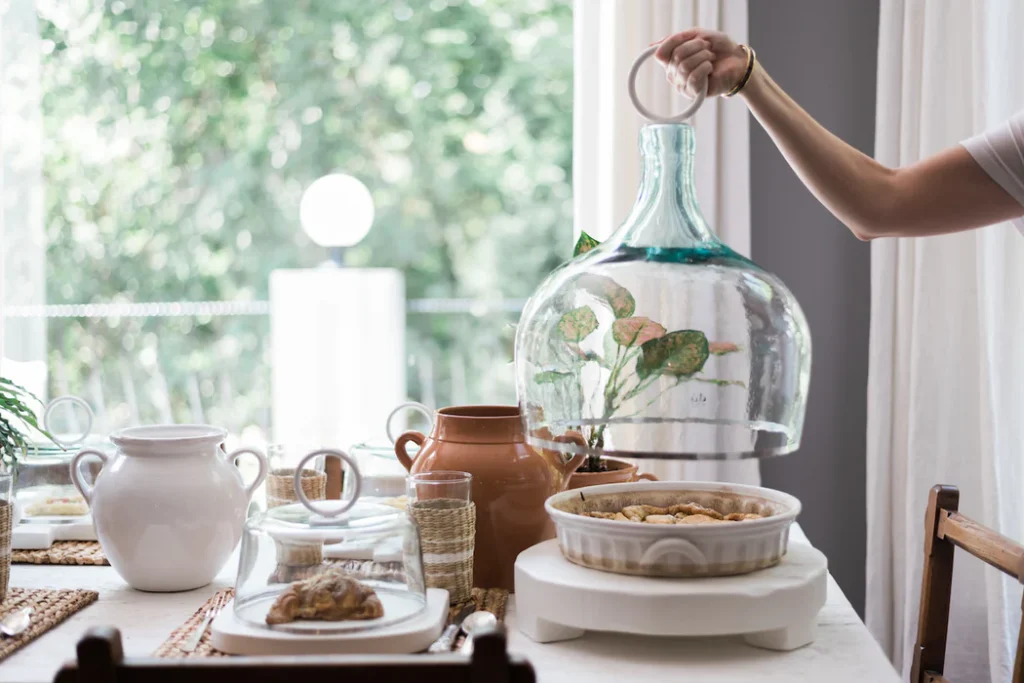Cloches have served as a versatile and elegant solution in gardening, dining, and fashion for centuries. Derived from the French word for “bell,” a cloche is a domed structure, often made of glass, fabric, or metal, with uses that range from protecting plants to serving food or defining vintage fashion trends. This article explores the multifaceted nature of cloches, detailing their history, modern applications, and how they enhance both practicality and style.
What Is a Cloche?
A cloche, meaning “bell” in French, is a bell-shaped cover designed for various uses. In gardening, it protects young plants from cold and pests. In dining, it’s a domed cover used to maintain food temperature or add theatrical flair. Fashion enthusiasts know it as a close-fitting hat popularized in the 1920s.
The History of the Cloche
Origin and Evolution
The concept of the cloche dates back to 19th-century France. Originally crafted from glass, it was used to shield delicate plants from frost and harsh weather. Over time, the cloche transitioned into other domains, influencing culinary presentation and inspiring one of the most iconic hat styles of the 20th century.
Cultural Significance
Cloches have remained relevant across generations due to their functional versatility and aesthetic appeal. Whether enhancing a gardener’s toolkit, gracing a dining table, or crowning a stylish outfit, cloches have become synonymous with sophistication and innovation.
Types of Cloches
Garden Cloche
Garden cloches are protective covers, typically made of glass or plastic. They help create a microclimate for plants, promoting growth by trapping warmth and moisture.
Food Cloche
These are used in culinary settings to cover plates and keep food warm while elevating the dining experience. Materials like stainless steel or glass are common in their construction.
Cloche Hat
The cloche hat, introduced in the early 1900s, is a bell-shaped, snug-fitting headpiece. Made from materials like felt, wool, or straw, it remains a symbol of vintage charm.
Benefits of Using a Cloche
- Gardening Advantages:
- Shields plants from frost and pests.
- Accelerates seed germination.
- Reduces the need for chemical pesticides.
- Culinary Appeal:
- Keeps food warm and fresh.
- Adds drama to food presentation.
- Protects dishes from contamination.
- Fashion Statement:
- Complements various outfits.
- Embodies a retro aesthetic.
- Offers practicality during colder months.
How to Use a Garden Cloche
- Placement: Position the cloche over seedlings or plants to provide a controlled environment.
- Ventilation: Open the cloche slightly during warmer days to prevent overheating.
- Maintenance: Clean the cloche regularly to ensure sunlight reaches the plants.
Designing a Garden with Cloches
Step-by-Step Guide
- Choose the Right Cloche: Opt for glass for elegance or plastic for durability.
- Position Strategically: Place cloches over temperature-sensitive plants.
- Incorporate Variety: Use different sizes and shapes for a visually appealing garden layout.
- Add Accents: Surround cloches with gravel or mulch for a polished look.
Tips for Optimal Results
- Use cloches during early spring or late fall for the best results.
- Combine with other protective gardening tools for a comprehensive approach.
The Cloche Hat: A Fashion Icon
Styling Tips
The cloche hat pairs beautifully with dresses, skirts, or trench coats. Modern adaptations feature embellishments like bows or sequins, making them a versatile accessory.
Creative Uses for Cloches at Home
- Terrariums: Turn a garden cloche into a miniature indoor garden.
- Decorative Displays: Use cloches to showcase candles, fairy lights, or seasonal decorations.
- Preserving Artifacts: Protect delicate antiques or heirlooms by enclosing them in a cloche.
Caring for Your Cloche
Cleaning Techniques
- Glass Cloches: Use a gentle glass cleaner and a soft cloth.
- Plastic Cloches: Avoid harsh chemicals to prevent discoloration.
- Fabric or Hat Cloches: Handwash or dry-clean, depending on the material.
Popular Trends Featuring Cloches
Cloches are making a comeback in both gardening and home décor. Gardeners are integrating solar-powered lights with cloches for nighttime displays. In fashion, the resurgence of 1920s-inspired outfits has brought the cloche hat back into the limelight.
Conclusion
The cloche is more than just a bell-shaped cover; it’s a testament to ingenuity and timeless design. Whether enhancing your garden, dining table, or wardrobe, cloches combine form and function in ways few other tools can. By understanding their history, uses, and care, you can incorporate cloches into your life to add both practicality and beauty.
FAQs
What materials are cloches made from?
Cloches can be made from glass, plastic, fabric, or metal, depending on their intended use.
Can cloches be used indoors?
Yes, cloches are often used for indoor terrariums, food presentation, and decorative purposes.
Are cloche hats still in style?
Absolutely. Cloche hats remain a timeless fashion accessory, frequently seen in retro-inspired wardrobes.
How do I choose the right cloche for my garden?
Consider factors like material, size, and weather conditions to select the best cloche for your plants.
Do cloches require special maintenance?
Cleaning and occasional repairs may be necessary to maintain their functionality and aesthetic appeal.
Where can I buy cloches?
Cloches are available at garden centers, home décor stores, and online retailers.



